Introduction
Machine learning has revolutionized the way content marketers create content. It gave deep insights into what actually the search engine bots crawl and how they understand the natural language. Writing content today is a lot different than it was 15 years ago. In the past, the content was created for the Search Engines, which was enough to rank the website high. But, today, valuable content is not the one made specifically for search engines.
In fact, creating such content can even have a counter effect and have your website evaluated as not authoritative, and in worse cases – penalized. No, today’s valuable content must put the target reader in the focus and give answers to their questions. It must nurture the target reader by providing them with all the essentials in written form so that they can solve their problem for which they went searching on Google. Hence, machine learning and Natural Language Processors today exist to ease this process. Here is everything you should know about the natural language processing basics and their practical application.
What Is Natural Language Processing?
Natural Language Processing, or shortly NLP, is the automatic manipulation of natural language (speech and text) done by software. With the development of computational linguistics, which uses computer science tools to study linguistics, the NLP became an inevitable part of how the search engines understand what the content you have written is about.
NLP’s main goal is to characterize and explain the multitude of linguistic observations that surround us. Related to this is the cognitive side of language, which is all about understanding and receiving language. Machines are trying to understand speech and text in the same way we, humans, do. Hence, NLP covers any kind of computer manipulation of natural language. It includes a vast range of activities – from counting the frequency of words to comparing different writing styles.
With the pace of development, the NLP is trying to achieve its ultimate goal – to understand complete human utterances and be able to give meaningful responses to them. To do so, it involves automatic computational processing of human languages that have algorithms to understand the human-produced text as input and algorithms that produce natural-looking text as outputs.
NLP API Google Cloud
With Google’s own NLP API, understanding how the search engine bots evaluate the quality of the text is brought closer to every content analyst. The tool uses machine learning to reveal the structure and the meaning of the text. You can see which information about people, places, and events Google extracts and considers relevant, so you can use these insights to craft content that Google will easily understand and get you closer to the target reader.
With the NLP API by Google, you can take a look at the syntax analysis of a chunk of content, extract tokens and sentences, identify parts of speech and create dependency parse trees for each sentence. Also, there is the entity analysis that identifies entities within the content and labels them by types: date, person, contact information, organization, location, events, products, and media.
Then, the sentiment analysis shows you the overall opinion, feeling, or attitude expressed in a block of text with a sentiment score. Finally, the customs classification shows how it classifies the content in more than 700 predefined categories.
Who Benefits the Most by Using NLP API?
As it can be concluded from above, NLP is used to understand the structure and the meaning of human language, which then is transformed into rule-based, machine learning algorithms that solve specific problems and perform desired tasks. Content marketers, strategists, and writers can use it to understand how computers understand the human language and use this knowledge when crafting their own pieces of writing.
It is all about the keyword phrases that are used within the content – they direct the NLP API tool to categorize the content appropriately. However, it is not that simple. All the sematic, morphological, and syntactical features are included in the processing. The general benefits of the NLP API are the following:
-
Extensive analysis
With the tool, machines can automatically understand and analyze lots of unstructured text data, from comments on social media, reviews, news, articles, and many more.
-
Sort out information in real-time
The tool helps the machine sort out all the information about the content in real-time without the help of humans. And best of all, it is done quickly, accurately, and efficiently.
-
Niche-tailored
The fact that you can use the NLP API tool to understand how it evaluated content specific to your needs and criteria is what makes it a state-of-the-art tool. Keep in mind that it is being developed so much that it can understand complex, industry-specific language, including sarcasm and misused words.
How does NLP API work?
It is a complex process, but to explain it simply, one should know that the tool transforms the text into a comprehensible unit for the machine by using text vectorization. Then, training data and expected outputs are fed to the machine learning algorithms so that associations between inputs and outputs can be made. From here, machines use statistical analysis methods to build their own “knowledge bank.” To fully understand this, one should also know what is text classification and how it provides the necessary data.
Practical Examples of Analysis
Let’s have a look at how a chunk of text is analyzed with the tool.
Let’s use this as an extract:
“Ever since the advent of Globalisation, the environment in which a business operates is constantly changing. An important component of the business environment is the technological environment. Technology, also, as we all know, is constantly changing, updating with new trends coming in every day.
Thus, it becomes imperative for businesses to understand and keep up with the technology trends to survive in the market.
One thing that has taken the IT industry by a storm is Machine Learning and Artificial Intelligence. AI and ML have innumerable applications which can upgrade and transform the way your business works.
So, whether or not, your business is in the IT sector, it is essential that Business Leaders know the AI and ML trends and can keep up with the pace and change of the business environment.”
Taken from the article Quick Guide to AI and ML Universe for Business Leaders from Analytics Vidhya Blog.
Entity Analysis
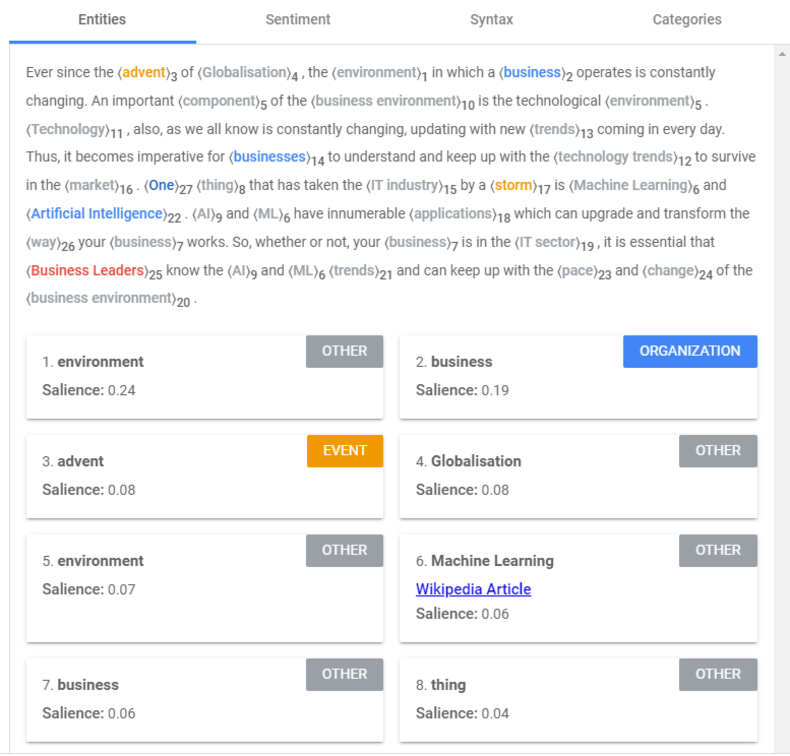
Sentiment Analysis
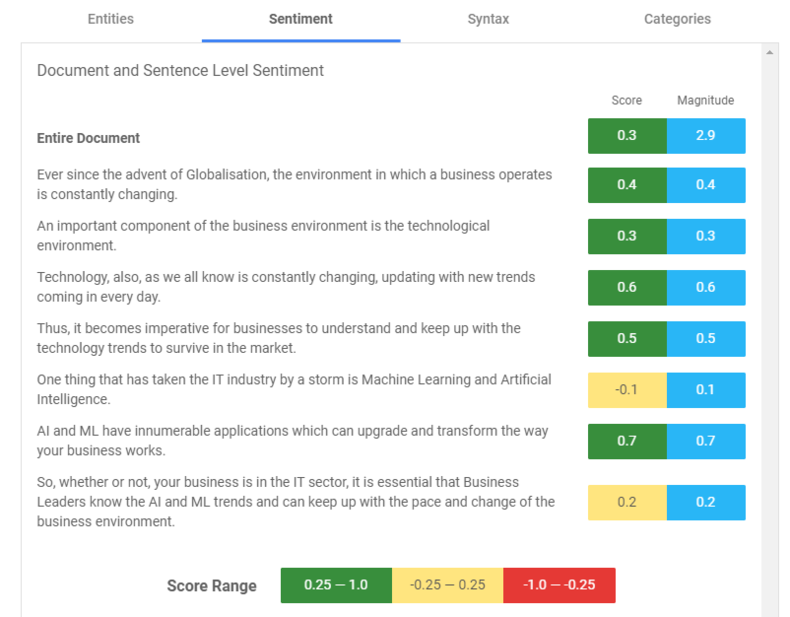
Syntax Analysis
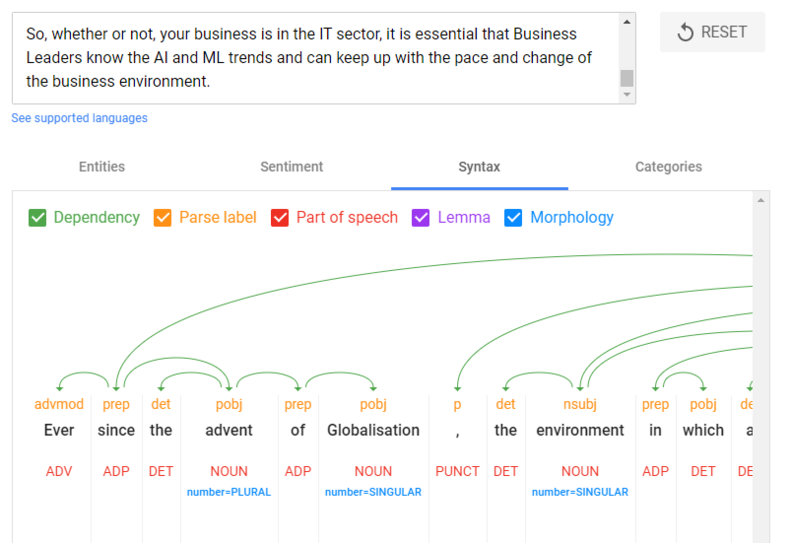
Categorization
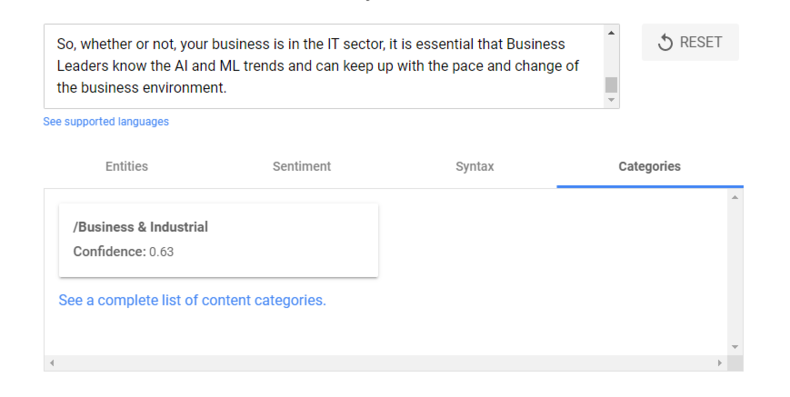
As it can be seen from the images above, the content is analyzed in 4 categories: entities, sentiment, syntax, and categories. The analysis gives insights into how the machine learning processes perceive the written content and how it is fed to the search engine bots. All of the data that is analyzed with the tool actually gets crawled by the search engine crawlers and receives the info about what it is and who it is intended for. Also, the crawlers are able to determine the reliability and the authenticity of the content from the analysis.
The opportunity that any person can explore how the NLP API sees the content and understands it gives feedback to these people who want to create optimized content ready to offer valuable info to target audiences. It is a cycle in which content marketers can be part of and take advantage of the insights into how machine learning works.
Comparison of Two Written Pieces of Writing Same Niche
Now, let’s take a more investigative step – let’s see two examples of the written text on two different websites, how they are analyzed with NLP API and which one of them performs better in the SERP.
“Machine Learning is the field of study that gives computers the capability to learn without being explicitly programmed. ML is one of the most exciting technologies that one would have ever come across. As it is evident from the name, it gives the computer that makes it more similar to humans: The ability to learn. Machine learning is actively being used today, perhaps in many more places than one would expect.”
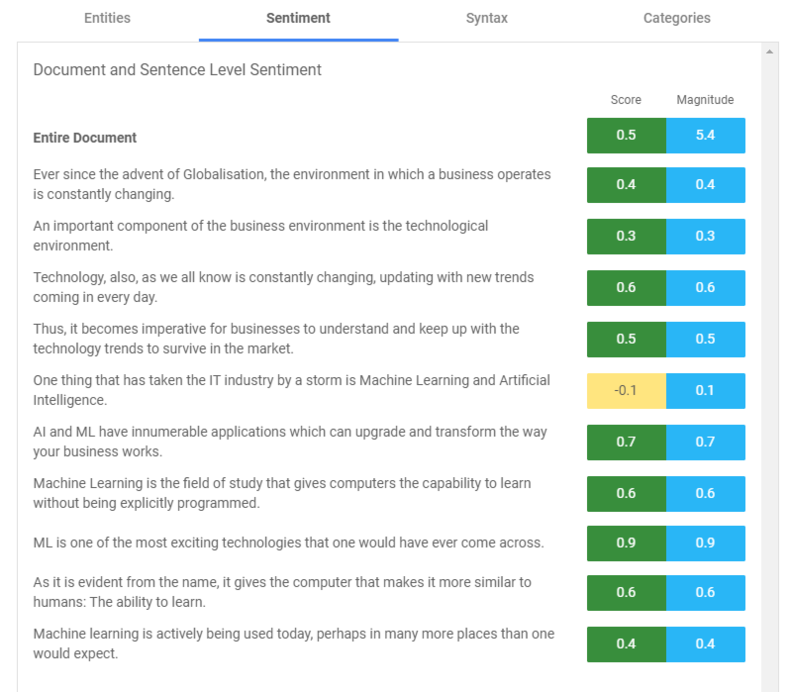
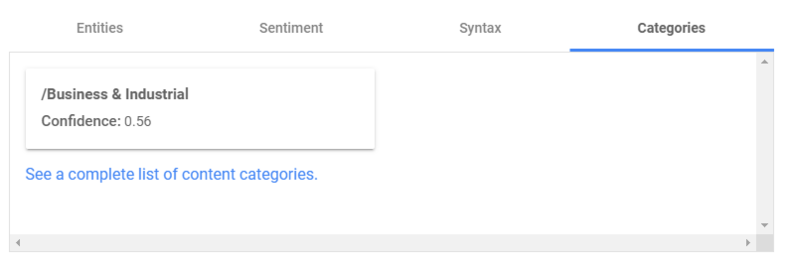
“Machine-learning algorithms are responsible for the vast majority of the artificial intelligence advancements and applications you hear about. (For more background, check out our first flowchart on “What is AI?”)
What is the definition of machine learning?
Machine-learning algorithms use statistics to find patterns in massive* amounts of data. And data, here, encompasses a lot of things—numbers, words, images, clicks, what have you. If it can be digitally stored, it can be fed into a machine-learning algorithm.
Machine learning is the process that powers many of the services we use today—recommendation systems like those on Netflix, YouTube, and Spotify; search engines like Google and Baidu; social-media feeds like Facebook and Twitter; voice assistants like Siri and Alexa. The list goes on.”
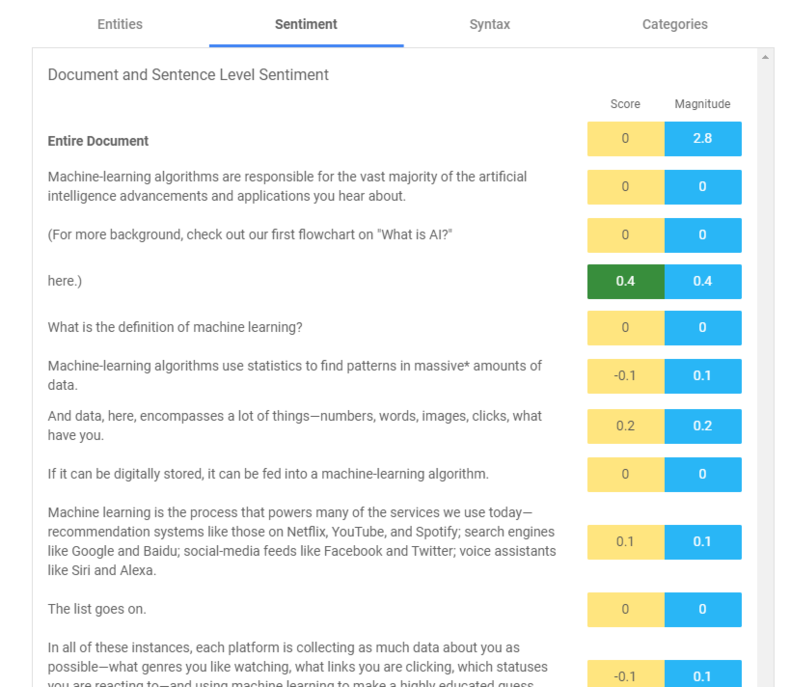

And here is how both results perform on SERP.
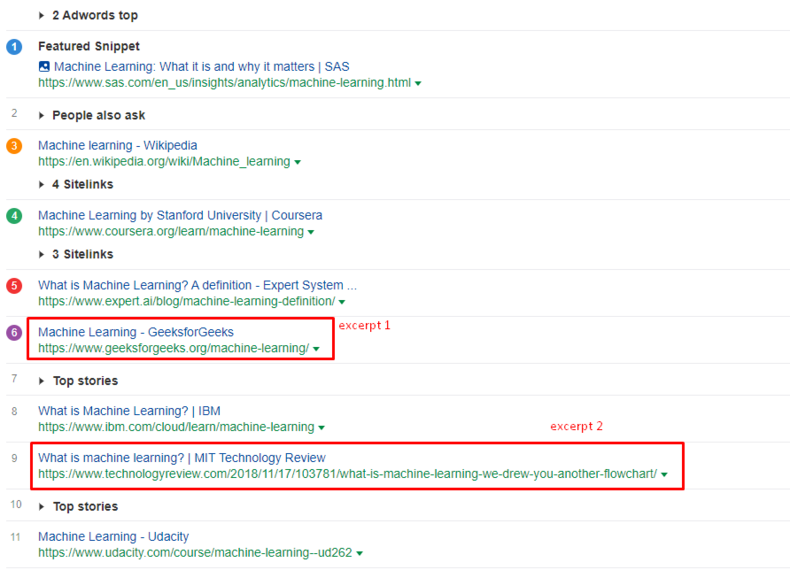
As you can see, the result that contains Excerpt 1 ranks better than the result with Excerpt 2 on Google’s first page. Notice how the NLP API has analyzed the content and how Excerpt 1 score higher in magnitude and how even though both excerpts are for “machine learning,” they are categorized differently – the first one in Business & Industrial with a score of 0.56 while the second one is Science/Computer Science with a score of 0.83. The difference in categorization directs the content analyst to see which piece of writing is appropriate for business and science. Taking this into consideration, the content writer will know what kind of content to produce.
Key Takeaways
What should be noted and paid attention to when using the NLP API?
You should know that NLP API has a demo version that you can try out. However, it is not free to implement and use. Regardless, the benefits are huge. It immensely facilitates the way content marketers understand how machines understand human language and use this knowledge to create content both for target audiences and search engine bots. It is strongly recommended to take advantage of its features and analytic tools.
Branko Ilishev
Co-Founder and Head of SEO at SmartClick, SEO and Web Agency that delivers digital solutions to help business website owners overtake their competitors and get more market share with a high-converting website and powerful SEO strategies.
The media shown in this article are not owned by Analytics Vidhya and is used at the Author’s discretion.






Regarding the categorization. Correct me if I am wrong but Googles Topic Layer was built/trained on Wikipedia articles/content. So, when content is categorized is it essentially taking the content and giving it a point on a vector graph that is sort of sectioned off categorically? I don't think I'm wording it correctly but I guess in a nutshell "What determines the category?"
Greattt. But just a quick question. All the images in this article, where can you get this data? 'Cause I don't see the similar appearance on my Cloud Console. Thanks in advance.